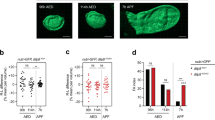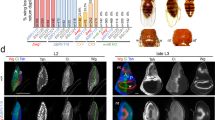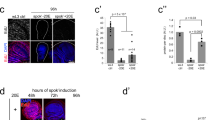Abstract
During animal development, organs grow to a fixed size and shape. Organ development typically begins with a rapid growth phase followed by a gradual decline in growth rate as the organ matures1, but the regulation of either stage of growth remains unclear. The Wnt/Wingless (Wg) proteins are critical for patterning most animal organs, have diverse effects on development and have been proposed to promote organ growth2. Here we report that contrary to this view, Wg activity actually constrains wing growth during Drosophila melanogaster wing development. In addition, we demonstrate that Wg is required for wing cell survival, particularly during the rapid growth phase of wing development. We propose that the cell-survival- and growth-constraining activities of Wg function to sculpt and delimit final wing size as part of its overall patterning programme.
This is a preview of subscription content, access via your institution
Access options
Subscribe to this journal
Receive 12 print issues and online access
$209.00 per year
only $17.42 per issue
Buy this article
- Purchase on Springer Link
- Instant access to full article PDF
Prices may be subject to local taxes which are calculated during checkout




Similar content being viewed by others
References
Bryant, P.J. & Simpson, P. Intrinsic and extrinsic control of growth in developing organs. Q. Rev. Biol. 59, 387–415 (1984).
Serrano, N. & O'Farrell, P.H. Limb morphogenesis: connections between patterning and growth. Curr. Biol. 7, 186–195 (1997).
Zecca, M., Basler, K. & Struhl, G. Direct and long-range action of a wingless morphogen gradient. Cell 87, 833–844 (1996).
Neumann, C.J. & Cohen, S.M. Long-range action of Wingless organizes the dorsal–ventral axis of the Drosophila wing. Development 124, 871–880 (1997).
Bryant, P.J. & Levinson, P. Intrinsic growth control in the imaginal primordia of Drosophila, and the autonomous action of a lethal mutation causing overgrowth. Dev. Biol. 107, 355–363 (1985).
Garcia-Bellido, A. & Merriam, J.R. Parameters of the wing imaginal disc development of Drosophila melanogaster. Dev. Biol. 24, 61–87 (1971).
Fain, M.J. & Stevens, B. Alterations in the cell cycle of Drosophila imaginal disc cells precede metamorphosis. Dev. Biol. 92, 247–258 (1982).
Graves, B. & Schubiger, G. Cell cycle changes during growth and differentiation of imaginal leg discs in Drosophila melanogaster. Dev. Biol. 93, 104–110 (1982).
O'Brochta, D.A. & Bryant, P.J. A zone of non-proliferating cells at a lineage restriction boundary in Drosophila. Nature 313, 138–141 (1985).
Johnston, L.A. & Edgar, B.A. Wingless and Notch regulate cell-cycle arrest in the developing Drosophila wing. Nature 394, 82–84 (1998).
Struhl, G. & Basler, K. Organizing activity of Wingless protein in Drosophila. Cell 72, 527–540 (1993).
Neufeld, T., de la Cruz, A.F., Johnston, L.A. & Edgar, B.A. Coordination of growth and cell division in the Drosophila wing. Cell 93, 1183–1193 (1998).
Chen, C.M. & Struhl, G. Wingless transduction by the Frizzled and Frizzled2 proteins of Drosophila. Development 126, 5441–52 (1999).
Wehrli, M. et al. arrow encodes an LDL-receptor-related protein essential for Wingless signalling. Nature 407, 527–530 (2000).
van de Wetering, M. et al. Armadillo coactivates transcription driven by the product of the Drosophila segment polarity gene dTCF. Cell 88, 789–799 (1997).
Milan, M., Campuzano, S. & Garcia-Bellido, A. Developmental parameters of cell death in the wing disc of Drosophila. Proc. Natl Acad. Sci. USA 94, 5691–5696 (1997).
Hay, B.A., Wolff, T. & Rubin, G.M. Expression of baculovirus P35 prevents cell death in Drosophila. Development 120, 2121–2129 (1994).
Cifuentes, F.J. & Garcia-Bellido, A. Proximo-distal specification in the wing disc of Drosophila by the nubbin gene. Proc. Natl Acad. Sci. USA 94, 11405–11410 (1997).
Azpiazu, N. & Morata, G. Function and regulation of homothorax in the wing imaginal disc of Drosophila. Development 127, 2685–2693 (2000).
Casares, F. & Mann, R.S. A dual role for homothorax in inhibiting wing blade development and specifying proximal wing identities in Drosophila. Development 127, 1499–1508 (2000).
Du, W., Xie, J. & Dyson, N. Ectopic expression of dE2F and dDP induces cell proliferation and death in the Drosophila eye. EMBO J. 15, 3684–3692 (1996).
Asano, M. & Wharton, R.P. E2F mediates developmental and cell cycle regulation of ORC1 in Drosophila. EMBO J. 18, 2435–2448 (1999).
Nolo, R., Abbott, L.A. & Bellen, H.J. Drosophila Lyra mutations are gain-of-function mutations of senseless. Genetics 157, 307–15 (2001).
Cox, R.T. et al. A screen for mutations that suppress the phenotype of Drosophila armadillo, the β-catenin homolog. Genetics 155, 1725–1740 (2000).
van de Wetering, M. et al. The β-catenin–TCF-4 complex imposes a crypt progenitor phenotype on colorectal cancer cells. Cell 111, 241–250 (2002).
Pignoni, F. & Zipursky, S. Induction of Drosophila eye development by decapentaplegic. Development 124, 271–278 (1997).
Nellen, D., Burke, R., Struhl, G. & Basler, K. Direct and long-range action of a DPP morphogen gradient. Cell 85, 357–368 (1996).
Johnston, L.A., Prober, D.A., Edgar, B.A., Eisenman, R.N. & Gallant, P. Drosophila Myc regulates cellular growth during development. Cell 98, 779–790 (1999).
Lee, T. & Luo, L. Mosaic analysis with a repressible cell marker for studies of gene function in neuronal morphogenesis. Neuron 22, 451–461 (1999).
Acknowledgements
L.A.J. very gratefully acknowledges the continual encouragement and generous support of Bruce Edgar, in whose lab this work was started. We thank K. Shah, E. Yoshida and L. Gatto for technical assistance, T. Jessel and I. Schieren for FACS use and assistance, and B. Edgar, I. Greenwald, T. Jessel, R. Mann, G. Struhl, A. Tomlinson, and members of the Johnston lab for comments on the manuscript. This work was supported in part by the V Foundation for Cancer Research, NY Speaker's Fund for Biomedical Sciences (L.A.J.) and the National Institutes of Health (HD42770 to L.A.J, GM51186 to B. Edgar). L.A.J. is a V Foundation Scholar.
Author information
Authors and Affiliations
Corresponding author
Ethics declarations
Competing interests
The authors declare no competing financial interests.
Supplementary information
Rights and permissions
About this article
Cite this article
Johnston, L., Sanders, A. Wingless promotes cell survival but constrains growth during Drosophila wing development. Nat Cell Biol 5, 827–833 (2003). https://doi.org/10.1038/ncb1041
Received:
Accepted:
Published:
Issue Date:
DOI: https://doi.org/10.1038/ncb1041
This article is cited by
-
Conceptual framework for the insect metamorphosis from larvae to pupae by transcriptomic profiling, a case study of Helicoverpa armigera (Lepidoptera: Noctuidae)
BMC Genomics (2022)
-
Xrp1 is a transcription factor required for cell competition-driven elimination of loser cells
Scientific Reports (2018)
-
Chromatin organization changes during the establishment and maintenance of the postmitotic state
Epigenetics & Chromatin (2017)
-
Hedgehog signalling is required for cell survival in Drosophila wing pouch cells
Scientific Reports (2017)
-
Wingless gene cloning and its role in manipulating the wing dimorphism in the white-backed planthopper, Sogatella furcifera
BMC Molecular Biology (2014)



